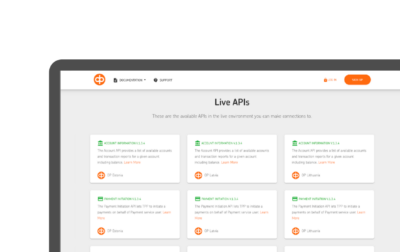Software development security best practices: A developer’s guide
We live in a world that is constantly plugged in and connected. But with great technologies comes a great dark side: craftier, more devastating cyber threats.
Data breaches have impacted big businesses like Trello, Fujitsu, Roku, Dropbox, and Dell since the start of 2024. That also applies to financial institutions; industry titans JPMorgan Chase and Bank of America shared the same fate.
As stated by Statista, the average cost of a data breach increased from 4.35 million in 2022 to 4.5 million in 2023. With an astounding average price of 11 million US dollars, healthcare has the highest average cost of a data breach. With 5.9 million, the banking industry ranks second.
But what does it take to stop breaches from occurring? In this article, we share the best practices a software developer or company should adopt to guarantee the safety and reliability of their solutions.
How to build a security-oriented mindset
In software engineering, nothing is more crucial than being diligent about safeguarding your systems and data. Let’s look at various approaches that could help you achieve this.
! Touchlane’s pro tip: Read our guide on Android security
DevSecOps
DevSecOps is the integration of security testing into the development process at every stage. It stands as the acronym for development, security, and operations and is an advancement of the DevOps methodology. It consists of procedures and technologies that promote cooperation between operation teams, security experts, and developers.
Here’s how adopting DevSecOps can improve secure development practices within your company:
- DevSecOps catches vulnerabilities at the first stages of software development, when fixing them is less complicated and costly.
- It relies on automated tools. This frees up the security team to focus on more challenging issues, while basic security hygiene is maintained throughout the development process. Continuous monitoring helps to detect potential issues before it may be exploited.
- DevSecOps fosters better communication and cooperation between security teams, operations, and developers. As a result, the development process inevitably becomes more secure.
Threat modeling
Imagine playing a war game from the defender’s point of view. You have to consider potential ways that an attacker could try to take advantage of your vulnerabilities and then work out countermeasures. That’s what threat modeling essentially is.
Threat modeling is a process that helps secure systems and data by utilizing testing, system diagrams, and hypothetical situations. It contributes to enhanced cybersecurity and confidence in critical business systems by detecting weaknesses, assisting with risk assessment, and making correction suggestions.
! Watch the following video for a great graphic explanation of threat modeling: What is Threat Modeling and Why Is It Important?

Fundamentals of safe coding
Secure software defends apps from malicious attacks and vulnerabilities, much like a well-constructed fortress defends its occupants. Below, our team at Touchlane suggests four fundamentals that you need to know to develop threat-resistant apps.
Validation and sanitization of input
Insecure software is like a fortress with open gates. And validation and sanitization are the gatekeepers that ensure your system only receives authorized data.
Validation determines if the input satisfies a number of requirements (e.g., a string must not contain a single, independent quote mark). Sanitization tinkers with the input to make sure it is legitimate (doubling single quotes, for example).
Common vulnerabilities like SQL injection and cross-site scripting (XSS) can be eliminated by implementing the validation and sanitization strategy.
Hashing and encryption
In your digital fortress, data is the treasure, and storing it securely in a vault is paramount. This is what hashing and encryption are for. While they serve the same purpose of data protection, these methods are significantly different from one another.
As if your data were a fingerprint, hashing functions turn information into an exclusive, irreversible string. Secure password storage is a common usage for this. Encryption scrambles data using a secret key and renders the information completely unintelligible without it. This is crucial to protect sensitive data, such as credit card details.

Principle of least privilege
Imagine that everyone has a key to your fortress and all the disasters that may happen because of it. In coding, this could be amended by the principle of least privilege. It stipulates that processes and users must only have the minimal access rights essential for them to fulfill their tasks. This reduces the possible consequences of a security breach.
Essentially, when you apply the principle of least privilege, you issue specific keys to particular areas within your fortress, restricting access to only what is necessary.
Avoiding common errors and securing coding libraries
Last but not least, you cannot protect your fortress properly if you do not build strong walls around it. Software-wise, we talk about safe coding practices. They encompass a mindset and approach to development. Listed below are some important rules to remember.
- Avoid common errors. Vulnerabilities often arise from common coding mistakes. Learn about typical pitfalls and use tools such as static code analysis to find possible issues. Observe guidelines and security requirements for software development, including those offered by OWASP and CERT.
- Secure coding libraries. Implementing third-party libraries and frameworks may seem like a good solution to accelerate the secure application development process. But not all libraries are created equal. You need to choose well-maintained, secure libraries from reputable sources. Reliable libraries offer a firm foundation for your software, much like utilizing sturdy building materials to construct your fortress.
By comprehending and putting these principles into practice, you can significantly bolster your app’s security. But you need to remember that security is an ongoing process, not a one-time fix. Stay vigilant, keep learning, and build fortresses that can withstand the digital siege.
! Touchlane’s pro tip: Delve deeper into the topic of safe coding fundamentals with the Fundamental Practices for Secure Software Development.
Tools and techniques for developers
Cybersecurity is a battlefield. With so many threats out there, developers need to have a well-equipped arsenal of tools and techniques to ward the threats off.
At Touchlane, we suggest the following three techniques as the base for your security efforts.
Integrated Development Environment (IDE)
IDE serves as a one-stop shop for every one of your development needs. It offers debugging tools, syntax highlighting, a code editor, and integration with Git and other version control systems. Eclipse, IntelliJ IDEA, and Visual Studio are a few of the well-known IDEs.
Many IDEs support plugins that enrich their capabilities. For instance, the Checkmarx and SonarQube plugins can be incorporated straight inside the development environment to give constant security input as the code is being written.
Static Application Security Testing (SAST)
Before the application is even launched, possible vulnerabilities are discovered through the analysis of source code using SAST tools. SAST tools search the codebase for coding mistakes and weaknesses that could lead to security issues.
Here are popular SAST tools to check:
- SonarQube: offers thorough code quality and security analysis and supports a variety of programming languages
- Checkmarx: provides thorough security analysis with an emphasis on finding and fixing vulnerabilities
- Fortify Static Code Analyzer: a powerful tool for vulnerability detection, integrates with many development environments.
Dynamic Application Security Testing (DAST)
DAST tools find vulnerabilities that might be missed by SAST by simulating actual attacks against an operating application. They crawl through the app, looking for holes that an attacker might exploit. To guarantee that the application is secure before it is put into production, DAST is essential in the last phases of development. Issues like runtime issues and configuration errors that might not be seen with static analysis alone can be identified with this method.
These are some prominent DAST instruments:
- OWASP ZAP (Zed Attack Proxy): an open-source tool that identifies security holes in web applications
- Burp Suite: a feature-rich online application security testing platform with multiple tools for vulnerability hunting, crawling, and scanning
- Netsparker: an automated tool for detecting and reporting weaknesses in web applications.
Continuous security
Software is like a living organism: it is never truly complete. Like a human being needs medical checkups, software requires updates and improvements. Here is why:
- Patch management: regular updates help patch holes in security and lower the exploitation risk.
- Improved features: updates include enhancements that improve security, e.g. better encryption algorithms or standards for safe communication.
- Compliance: updating software guarantees adherence to rules and industry standards.
To manage weaknesses successfully, you must prioritize fixing vulnerabilities, checking for flaws, and keeping an eye out for fresh threats. In addition, establishing a robust security culture is crucial. Continuous training, rewards for excellent practices, and cooperation with the teams responsible for operations and security are all vital for developers. Organizations can drastically lower their risk of a cyberattack by combining frequent upgrades with a security-focused mentality.
Conclusion
Because cybersecurity threats constantly shift, it is necessary to remain vigilant and adaptable. Using these recommended procedures as developers helps to achieve the larger objective of upholding a secure digital ecosystem, in addition to safeguarding your company. Building reliable software that endures over time can be achieved by giving priority to the secure software development process.
Here at Touchlane, we hope you find this article insightful. With our rich expertise in developing secure software, our team will be happy to provide you with a consultation.
Contact our team
RELATED SERVICES
CUSTOM SOFTWARE DEVELOPMENT
If you have an idea for a product along with put-together business requirements, and you want your time-to-market to be as short as possible without cutting any corners on quality, Touchlane can become your all-in-one technology partner, putting together a cross-functional team and carrying a project all the way to its successful launch into the digital reality.
If you have an idea for a product along with put-together business requirements, and you want your time-to-market to be as short as possible without cutting any corners on quality, Touchlane can become your all-in-one technology partner, putting together a cross-functional team and carrying a project all the way to its successful launch into the digital reality.
We Cover
- Design
- Development
- Testing
- Maintenance











